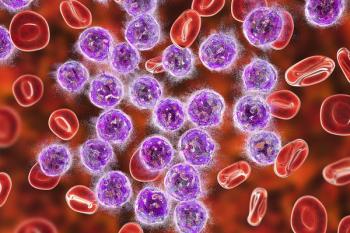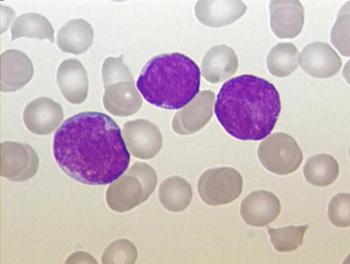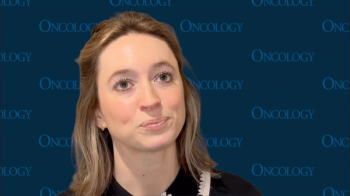
Oncology NEWS International
- Oncology NEWS International Vol 11 No 12
- Volume 11
- Issue 12
Emergence of Chronic Leukemias as Major Research Targets in Leukemia
In the last 20 yearsof the past millennium,most clinical researchin leukemiawas directed towardimproving prognosisof acute leukemia andstudying the role ofstem cell transplantation(SCT), both autologousand allogeneic,in these diseases.The emergence of new treatments and therapeuticapproaches has dramatically changed the emphasisof clinical research in leukemia. The power ofeffective new agents to transform clinical research hasbeen illustrated by the emergence of the tyrosine kinaseinhibitor imatinib mesylate (Gleevec, STI-571) inchronic myeloid leukemia and monoclonal antibodiesin chronic lymphocytic leukemia (CLL).
In the last 20 yearsof the past millennium,most clinical researchin leukemiawas directed towardimproving prognosisof acute leukemia andstudying the role ofstem cell transplantation(SCT), both autologousand allogeneic,in these diseases.The emergence of new treatments and therapeuticapproaches has dramatically changed the emphasisof clinical research in leukemia. The power ofeffective new agents to transform clinical research hasbeen illustrated by the emergence of the tyrosine kinaseinhibitor imatinib mesylate (Gleevec, STI-571) inchronic myeloid leukemia and monoclonal antibodiesin chronic lymphocytic leukemia (CLL).Major advances in the management of Philadelphia-chromosome-positive chronic myelogenous leukemia(Ph-1 CML) occurred following the introductionof interferon (IFN). Initial studies with human leukocyteinterferon followed by those with recombinantalpha interferon and combinations of r-IFN-? plusAra-C (cytosine arabinoside) led to a doubling of theexpected survival during the past 20 years. Similarly,allogeneic bone marrow transplantation (allo-BMT)using either marrow or stem cells from peripheralblood became the "poster child" of transplantation.While a number of interferon-treated patients haveremained free of recurrence, off IFN for a number ofyears, allo-SCT is considered the only proven curativestrategy, particularly in patients under the age of 30.The development of STI-571 has been revolutionary.The ability of this agent to specifically inhibit ablbcrtyrosine kinase has led to an extremely highcomplete response rate in CML. Thus an oral preparationhas transformed the expectation for this disease.Following promising phase I studies, the phase III(IRIS) trial (page 19) comparing STI-571 to interferonenrolled over 1,000 patients, and compared imatinib400 mg/d to interferon plus Ara-C. The complete andmajor cytogenetic response rate with imatinib wasdramatically superior to that with interferon/Ara-C.A second clinical trial called SPIRIT will try to confirmthese earlier studies. At the American Society ofHematology meeting in 2001, investigators from theM. D. Anderson Cancer Center demonstrated a higherand more rapid complete response rate with imatinib800 mg/d than with the conventional 400 mg/ddose. Whether these studies can lead to longer-termcontrol is uncertain. STI-571 has also emerged as amajor advance in the management of both the acceleratedand blastic phases of CML. However, in theselatter two conditions, responses are not as durable asin previously untreated patients. In brief, STI-571 isassociated with a very high response rate, and at thepresent time the responses appear to be durable.A major issue that has arisen as the quality ofresponses has improved following STI-571 is the roleof monitoring. It is obvious that the "gold standard" isstill conventional cytogenetics. However, FISH (fluorescentin situ hybridization) studies were able to evaluatea larger number of cells and it appears more accuratethan cytogenetics. But the FISH methodology does notdiscover the emergence of new chromosome abnormalitiesunless other FISH probes are added to the abland bcr probes. In patients who achieve completecytogenetic and FISH responses, real-time PCR assayis emerging as a major new technique for monitoringthe number of gene copies, and in patients who haveminimal residual disease, will probably be the methodof choice in evaluating follow-up studies.The success of STI-571 has led to active debate as tothe role of allogeneic transplant in the Gleevec era.This will not be resolved for a substantial period of time.Thus, some investigators believe that until there is demonstrationthat STI-571 is curative, patients under theage of 20 and possibly under 30 should continue toreceive allogeneic SCT if a donor is available.The Future of CML
Studies are already emerging of combinations ofSTI-571 with interferon, Ara-C, and other agents. Acombination of interferon plus STI-571 appears to bemore myelosuppressive but otherwise well tolerated.There are different mechanisms of resistance to STI-571, which may be related to additional mutations orchromosome abnormalities, bcr-abl amplification, drugefflux or other kinase mutations. Other new agentsbeing explored include new tyrosine kinase inhibitorssuch as PD17 by the Memorial Sloan-Kettering group(page 20), PS-341 (a proteasome inhibitor), and farnesyltransferase inhibitors (FTI). Combinations of these agentsare also being evaluated.Chronic Lymphocytic Leukemia
The other area of leukemia that is undergoingtransformation is chronic lymphocytic leukemia. Whereasfor many years this disease was in the doldrums, theemergence of the purine analogs as a major chemotherapygroup has enlivened clinic research in thisarena. A series of studies have now confirmed thatfludarabine (Fludara) or 2-CDA (Leustatin) have higherresponse rates and longer time to treatment failurethan alkylator-based regimens. As these patients areoften salvaged with alternative regimens, there is nosurvival advantage demonstrated at the present time.The most influential clinical trials have been thefludarabine vs chlorambucil (Leukeran) trial conductedin North America with Dr. Kanti Rai as the principalinvestigator, and the French Cooperative Group comparingfludarabine to CHOP (cyclophosphamide, doxorubicin,vincristine [Oncovin], prednisone) and theFrench mini-CHOP. The latter study illustrated that theautoimmune hemolytic anemia incidence is similar inthe three groups, whereas formerly it had been associatedpredominantly with the purine analogs.The discovery of the activity of two monoclonalantibodies, namely rituximab (Rituxan) andalemtuzumab (Campath), is changing the status quoin CLL. While rituximab is minimally effective at conventionaldoses as salvage therapy in CLL, there is ahigh response rate of 70% to 80% when used asinitial therapy (page 21). Most of these responses arepartial responses and the remission durations are notlong. In patients who have been previously treated,the activity of rituximab is enhanced by a doseintensiveregimen with either a higher weekly dose ora three times a week schedule. The responses againare predominantly partial responses and median remissionduration is 9 to 12 months.Campath-1H (alemtuzumab) has been approvedfor the management of patients with fludarabinerefractorydisease (page 25). As opposed to formerexpectations of a response rate of approximately20% and a median survival of 9 months in thesepatients, Campath-1H was able to achieve a 33%response rate with a median survival of 16 months.Many of these responses are long lasting.Alemtuzumab given as initial therapy by the subcutaneousroute has been investigated by a Swedishgroup. The limitation of this subcutaneous route islocal reactions, which occur initially, but the responserate demonstrates that alemtuzumab is almostas effective as fludarabine as a single agent inpreviously untreated CLL. While there are concernsabout immunosuppression and transient myelosuppressionwith alemtuzumab and reactivation ofcytomegalovirus (CMV), which occurs in approximately20% of patients, the CMV reactivation canusually be readily managed with ganciclovir(Cytovene) or foscarnet (Foscavir) and patients cancontinue on their therapy. Studies of alemtuzumabas treatment for minimal residual disease demonstratethat half the patients can become PCR negativein their bone marrow. This agent does not appear tobe as effective in managing bulky lymph nodes.Combinations of monoclonal antibodies and otheragents are promising to elevate the complete responserate above 50% for the first time. The Cancerand Leukemia Group B have compared fludarabineat conventional doses with either simultaneous orsimultaneous rituximab. The overall and completeresponse rates are significantly superior for the simultaneousarm. There was an increase in neutropeniawith sequential fludarabine/rituximab, but no increasein infections or other complications. The role ofrituximab in maintenance of CLL is still uncertain.Combinations of fludarabine with cyclophosphamide(FC) have demonstrated promising results inphase II clinical trials. Reports from the German CLLstudy group have demonstrated that FC is superior tofludarabine alone in salvage therapy as far as responserate goes. The group at M. D. Anderson hasdeveloped a combination of FC plus rituximab (FCR)and has demonstrated a significantly higher responserate in salvage therapy than had been demonstratedpreviously (page 24). In the salvage therapy setting,myelosuppression with associated infections was doselimiting.However, 25% of patients in relapse mayachieve a complete response to the FCR combination.When FCR is given as initial therapy to patientswith CLL who require therapy according to the NCIWorking Group criteria, the complete remission rateis now 67%, with an overall response rate of 95%(page 21). In addition, 50% or more of the completeremissions become PCR negative for the immunoglobulinvariable heavy chain region, an accomplishmentthat was unexpected when this study was initiallyconducted. Remission duration appears to be prolongedat the present time, but there is no evidence asyet that a survival advantage has been obtained.Transplantation modalities have been increasinglyexplored in CLL (page 22). In the relapse setting, afterobtaining a response, autologous bone marrow transplantationmay prolong remission but does not leadto cure. We await an update from the Dana-FarberCancer Institute of their earlier study with autologousSCT as intensification of first-line chemotherapy-inducedremissions. A number of investigators concludethat graft-vs-leukemia effect is powerful in CLL,and that allogeneic SCT is associated with longerdisease-free survival than autologous SCT. The developmentof nonablative transplants (NSCT) or reducedintensity transplants (RIT) has expanded the range ofallogeneic options so that patients up to the age of70 to 75 are now being treated with NSCT.The Future of CLL
It is likely that the combinations of chemotherapyplus antibodies will become the new standard of carefor frontline and salvage therapy in CLL. New agentsare being investigated such as the bcl-2 antisense, PS-341, and new monoclonal antibodies. NSCT willcontinue to emerge as a significant salvage opportunity,and well-conducted clinical trials will need to beestablished to prove the efficacy of these strategies.AML and MDS
Acute myelogenous leukemia (AML) andmyelodysplastic syndrome (MDS) are in a phase whereexploration of the biology of the disease is of majorinterest. Application of gene chip microarrays (page29) is leading to determination of different gene profiles,which cluster in different forms of AML. Progresscontinues to be made in the implementation of combinationstrategies of retinoids such as ALL-transretinoicacid (ATRA) along with arsenic trioxide and anti-CD33antibodies in acute promyelocytic leukemia (APL). It isnow considered tragic when a patient with APL doesnot achieve a long-lasting complete remission. Goodresponses continue to be obtained in the specificchromosome abnormalities t(8;21) and inv16 withhigh dose Ara-C regimens. The major remaining areais those with diploid karyotypes and these are nowbeing identified as being associated with FLT-3 mutationsin 20% to 30% of patients with AML. It isassociated with high white cell counts and reducedlong-term survival. This can be on the basis of internaltandem duplications, mis-sense mutations or in frameinsertions. Inhibitors of FLT-3 continue to be exploredwith promising early results. The use of imatinib hasbeen disappointing in AML despite its activity againstc-kit. Farnesyl transferase inhibitors (FTIs) have beendeveloped as a way of interfering with ras. A varietyof FTIs inhibit this activity and R115777 has beenshown to reduce bone marrow ras activity in patientswith refractory AML and has resulted in complete andpartial remissions in some patients with AML.Myelodysplastic syndrome continues to be a majorarea of concern, as the only proven active agent appearsto be the growth factors, which increase productionof red cells and neutrophils and occasionally platelets,but this is cumbersome and expensive. High-dosechemotherapy is useful in some MDS patients with eithera diploid karyotype or specific translocations. Patientswith adverse or poor cytogenetic parameters such asabnormalities in chromosomes 5 and 7 continue to beunaffected by present strategies. Reduced-intensity transplantationhas been actively explored as therapy forinduction and consolidation of remission in AML andMDS. The future of AML and MDS lies in the developmentof new treatment strategies that explore the improvedunderstanding of the biology of these conditions.ALL
In adult ALL, the usefulness of imatinib is beingexplored in combination with a variety of chemotherapyprograms. Most chemotherapy programs such asthe BFM and hyper-CVAD regimens have high completeremission rates and an approximately 30% to40% long-term survival fraction. However, patientswho are Philadelphia chromosome-positive continueto relapse. There is a benefit from allogeneic SCT inthis circumstance and the addition of Gleevec tothese regimens is improving the complete remissionrate. Monoclonal antibodies have an effect in CD20-positive ALL. For B-cell ALL in which CD20 is highlyexpressed, early studies report high response ratesand longer remissions. These results will need to beconfirmed. Patients with higher levels of CD20 appearto have an inferior prognosis in adult ALL andthe addition of rituximab to chemotherapy promisesto be useful. There are some reports of improveddisease-free interval with allogeneic bone marrowtransplant in ALL (page 27), but with no survivaladvantage being demonstrated at this time.The leukemias continue to be an important avenuefor exploration of new treatment strategies. Theycontinue to be a source of discovery of new agentsand concepts. The maturation of studies of imatiniband combination chemoimmunotherapy in CML andCLL, respectively, is awaited with interest.
Articles in this issue
about 23 years ago
Stereotactic Radiosurgery Benefits Brain Met Patientsabout 23 years ago
Cancer Risk From Tainted Polio Vaccine Undetermined: IOM Reportabout 23 years ago
Tailored Messages Motivate Women to Get Mammogramsabout 23 years ago
Chemo/Rituximab Is Effective as First-Line CLL Therapyabout 23 years ago
Preoperative Capecitabine/RT Downstages Rectal Cancerabout 23 years ago
Intraoperative Lymphatic Mapping Enhances Cancer Stagingabout 23 years ago
Rituximab Ups Survival in Aggressive and Indolent NHLabout 23 years ago
Genzyme Molecular Oncology Begins Kidney Cancer Vaccine Trialabout 23 years ago
Lower Breast Cancer Survival in Hispanics: New Mexico StudyNewsletter
Stay up to date on recent advances in the multidisciplinary approach to cancer.





















































































